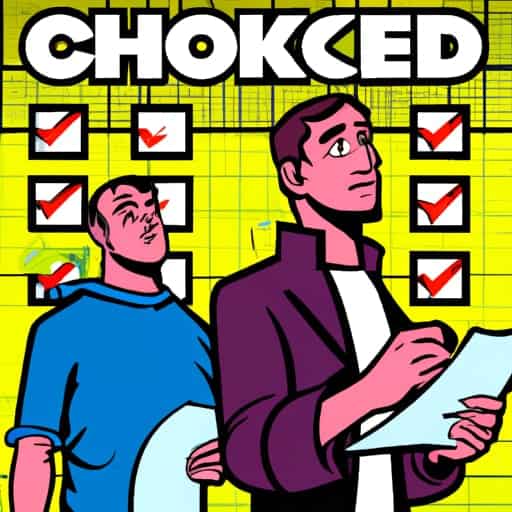Bipolar Disorder Checklist: Symptoms and Criteria to Help with Accurate Diagnosis

Introduction:
Bipolar disorder, also known as manic depression, is a disturbance of mood patternsr that affects millions of people worldwide.
However,
The condition is characterized by extreme mood swings that can range from periods of high energy and euphoria to periods of low energy and depression. While bipolar disorder is a lifelong condition, it can be managed with proper treatment and a good understanding of the symptoms. This article will provide you with a bipolar disorder checklist to help you identify the symptoms of this mood disorder.
Bipolar Disorder Checklist:
The following symptoms are commonly associated with bipolar disorder and can be used as a screening tool.
- Hypomanic episodes: episodes of high energy and euphoria that last for at least four days
- Depressive episodes: periods of low mood, low energy, and feelings of sadness or hopelessness that last for at least two weeks
- Extreme mood swings: sudden changes in mood from high to low, or vice versa, that last for several days to weeks
- Psychotic symptoms: delusions or hallucinations that occur during a manic or depressive episode
- Mood changes: significant changes in the individual’s typical patterns of sleep, activity, and energy levels
- Suicidal thoughts or suicide attempts: thoughts or actions that suggest an individual is considering or planning suicide

The Importance of Early Detection
Early detection and treatment of bipolar disorder is critical to improving outcomes for individuals with this condition. By detecting bipolar disorder early, you can reduce the risk of suicide attempts, improve overall mental health, and help individuals manage their symptoms more effectively. That’s why it’s important to be aware of the symptoms of bipolar disorder and to seek help if you suspect that you or a loved one may have this condition.
Primary care providers play a crucial role in the early detection and treatment of bipolar disorder. If you are experiencing symptoms of bipolar disorder, your first step should be to see your healthcare provider. They can perform a screening and refer you to a mental health professional for further evaluation and treatment if needed. Don’t hesitate to reach out to your doctor if you are concerned about your mental health. With the right support, it’s possible to manage the symptoms of bipolar disorder and live a fulfilling life.
The Prevalence of Bipolar Disorder
The prevalence of cyclothymic disorder in the general population is estimated to be between 0.4% and 1% with an equal ratio of males to females. In clinical settings, females are more likely to seek treatment.
It is believed that between 15-50% of individuals with cyclothymic disorder will develop bipolar I or II disorder.
People with cyclothymic disorder also have a higher likelihood of having major depressive disorder, bipolar I disorder, or bipolar II disorder in their biological first-degree relatives.
Bipolar I disorder has a lifetime prevalence of 1.6%, while bipolar II disorder has a prevalence of 0.5%.
Approximately 15% of adolescents with recurring major depression may have cyclothymia. The prognosis for cyclothymia can vary but can be managed through psychiatric treatment.
The Role of Psychometric Tests
Psychometric tests, such as self-administered questionnaires and structured clinical interviews, are commonly used in the assessment of bipolar disorder. While these tests can provide valuable information, they are not always perfect. Sensitivity and specificity are two important factors to consider when evaluating the accuracy of psychometric tests. Sensitivity refers to the test’s ability to correctly identify individuals who have the condition, while specificity refers to the test’s ability to correctly identify individuals who do not have the condition.
Two psychometric tests that are commonly used in the assessment of bipolar disorder are the Hypomania Checklist-32 (HCL-32) and the Bipolar Spectrum Diagnostic Scale (BSDS).
The HCL-32 is a self-administered questionnaire that screens for hypomanic symptoms, while the BSDS is a structured clinical interview that assesses the symptoms of bipolar disorder and other mood disorders. Both tests have good psychometric properties and have been used in various studies to assess the presence of bipolar disorder.
However, it’s important to keep in mind that no single test can provide a definitive diagnosis and that a comprehensive evaluation by a mental health professional is necessary to confirm the presence of bipolar disorder. (Really, don’t rely on TikTok for this, or even Uncle Google.)
The Semi-Structured Interview
Semi-structured interviews play a key role in the process of diagnosing bipolar disorder. These interviews are typically conducted by a mental health professional and involve asking questions about an individual’s symptoms, experiences, and medical history. The questions in a semi-structured interview are standardized and structured, but the interviewer has some flexibility to tailor the questions to the individual’s specific needs and experiences.
Semi-structured interviews are important for several reasons. First, they provide a structured way for the mental health professional to gather information about the individual’s symptoms, which can help to differentiate between bipolar disorder and other mood disorders. Second, the interviewer can ask follow-up questions and probe deeper into specific areas of concern, which can provide a more comprehensive understanding of the individual’s experiences. Third, semi-structured interviews can help to identify any co-occurring conditions, such as substance use disorders or anxiety disorders, which can have a significant impact on the individual’s overall mental health.

Diagnosis of Bipolar Disorder:
In order to make an accurate diagnosis of bipolar disorder, a health care provider will typically use a combination of a clinical evaluation, mood disorder questionnaire, and a structured clinical interview.
The 32-item hypomania checklist, also known as the Hypomania Checklist-32, is a commonly used screening tool for bipolar disorder.
The DSM-5 Bipolar Disorder Criteria can also be used as a reference for diagnosis. Blood tests, family history, and a study of the individual’s symptoms and behavior over time may also be taken into consideration.
DSM-5 Bipolar Disorder Criteria
The DSM-5 criteria for the diagnosis of bipolar disorder include the presence of manic, hypomanic, or mixed episodes. Manic episodes are defined as a period of elevated or irritable mood lasting for at least one week, accompanied by at least three of the following symptoms: grandiosity, decreased need for sleep, more talkative than usual, racing thoughts, distractibility, engaging in pleasurable activities with a high potential for painful consequences, and excessive involvement in activities that have a high potential for dangerous consequences.
Hypomanic episodes are similar to manic episodes, but the symptoms are less intense and last for at least four consecutive days. Mixed episodes are characterized by the presence of symptoms of mania and depression occurring at the same time.
In addition to the presence of manic, hypomanic, or mixed episodes, the DSM-5 criteria for bipolar disorder also include the presence of major depressive episodes, which are characterized by symptoms such as low mood, decreased interest or pleasure in activities, changes in appetite or sleep patterns, fatigue or loss of energy, feelings of worthlessness or guilt, and difficulty concentrating or making decisions.
The DSM-5 criteria also require that the symptoms cause clinically significant distress or impairment in social, occupational, or other important areas of functioning, and are not due to the direct physiological effects of a substance or a medical condition. Furthermore, the diagnosis of bipolar disorder can only be made if the symptoms are not better accounted for by another mental disorder.
ICD-10 Bipolar Disorder Criteria
The International Classification of Diseases (ICD-10) criteria for the diagnosis of bipolar disorder include the presence of manic or hypomanic episodes. Manic episodes are defined as a period of elevated, expansive, or irritable mood lasting for at least one week, accompanied by increased energy, decreased need for sleep, grandiosity, impulsiveness, and distractibility.
Hypomanic episodes are similar to manic episodes but with less intense symptoms, lasting for at least four consecutive days.
In addition to the presence of manic or hypomanic episodes, the ICD-10 criteria for bipolar disorder also include the presence of depressive episodes, characterized by symptoms such as low mood, decreased interest or pleasure in activities, changes in appetite or sleep patterns, feelings of worthlessness or guilt, and difficulty concentrating or making decisions.
The ICD-10 criteria also require that the symptoms cause clinically significant distress or impairment in social, occupational, or other important areas of functioning, and are not due to the direct physiological effects of a substance or a medical condition. Furthermore, the diagnosis of bipolar disorder can only be made if the symptoms are not better accounted for by another mental disorder.
ICD-10 is used in the UK and other parts of Europe while DSM-5 is mainly USA, but also in areas of American cultural influence.
Different Types of Mood Disorder
There are several different types of bipolar disorder, each with its own unique symptoms and patterns of mood changes. The most commonly recognized types of bipolar disorder are Bipolar I Disorder, Bipolar II Disorder, and Cyclothymic Disorder.
Major Depressive Episode is necessary for Dx of Bipolar I Disorder
is characterized by one or more manic episodes, which are periods of elevated or irritable mood that last for at least a week. During a manic episode, an individual may engage in impulsive or reckless behavior, have racing thoughts, and experience little need for sleep. Depressive episodes, which are periods of low mood that last for at least two weeks, also occur in individuals with Bipolar I Disorder.
Fewer Depressive Symptoms In Bipolar II Disorder?
is similar to Bipolar I Disorder, but it is characterized by hypomanic episodes rather than manic episodes. Hypomanic episodes are periods of elevated or irritable mood that last for at least four days, but they are not as severe or disruptive as manic episodes.
Milder Mood Swings in Cyclothymic Disorder,
also known as Cyclothymia, has bipolar symptoms in a milder form These are characterized by alternating periods of hypomania and mild depression. These episodes may not be as severe or disruptive as the episodes seen in Bipolar I Disorder or Bipolar II Disorder, but they can still have a significant impact on an individual’s daily life.
Proper diagnosis should only be made by a mental health professional (not TikTok or your mate, Sheila whose uncle had bipolar, so she says).
Remember: a correct diagnosis is crucial for ensuring that individuals receive the proper treatment and support for their condition.
Treatment of Bipolar Disorder:
The first step in the treatment of bipolar disorder is to receive a correct diagnosis from a mental health professional. Once a diagnosis has been made, a treatment plan can be developed that may include mood stabilizers, psychotherapy, and in some cases, medications to manage the symptoms. Substance use disorder and family history should also be taken into consideration when developing a treatment plan.

The Role of Family Members
The role of family members in helping a person with bipolar disorder is crucial. Family members can provide support, encouragement, and a sense of community to individuals with this condition. They can also help with managing symptoms, seeking medical care, and ensuring that their loved one follows their treatment plan.
Family members can also play an important role in helping their loved one recognize the signs and symptoms of an impending manic or depressive episode. They can also help their loved one stay on track with their treatment plan, which may include taking medication, attending therapy sessions, and engaging in healthy lifestyle habits.
It’s important for family members to educate themselves about bipolar disorder, its symptoms, and its treatment options. This can help them provide informed support and advocacy for their loved one. Additionally, family members can reach out to support groups or counseling services for themselves to help them manage the stress and strain of caring for a loved one with a mental illness.
It’s also important for family members to recognize their own limitations and to prioritize their own well-being. Caring for a loved one with bipolar disorder can be emotionally and physically draining, and it’s important for family members to take care of themselves and seek support when needed.
The Importance of Cultural Differences
nderstanding cultural differences is an important aspect in diagnosing bipolar disorder. Culture can influence how individuals understand and experience symptoms of mental illness, including bipolar disorder. For example, in some cultures, high levels of energy and impulsivity may be viewed as normal behavior, making it difficult to distinguish between hypomanic symptoms and culturally appropriate behavior.
Moreover, cultural norms and beliefs about mental illness can impact an individual’s willingness to seek help, their understanding of treatment options, and their overall perception of their condition. For example, some cultures may stigmatize mental illness or view it as a personal weakness, leading individuals to avoid seeking help or to downplay the severity of their symptoms.
It’s important for mental health professionals to be aware of cultural differences and to approach each patient with an open mind and a willingness to understand their unique experiences and perspectives. This can be accomplished by engaging in culturally sensitive practices, such as incorporating the patient’s own beliefs and cultural background into their treatment plan, using culturally appropriate language and resources, and seeking input from cultural brokers or community leaders.
Other Mental Health Problems That Can Look Like Bipolar
Bipolar disorder can sometimes be misdiagnosed or confused with other mental health conditions due to similarities in symptoms. Therefore, it’s important to consider differential diagnoses when evaluating an individual for bipolar disorder. Some common conditions that may be confused with bipolar disorder include:
- Major depressive disorder (MDD): MDD is characterized by prolonged periods of low mood and loss of interest in activities, without the manic or hypomanic episodes seen in bipolar disorder.
- Attention deficit hyperactivity disorder (ADHD): ADHD is a neurodevelopmental disorder characterized by inattention, impulsiveness, and hyperactivity. It is important to differentiate between ADHD and bipolar disorder as the treatment approach for each condition is different.
- Substance use disorder (SUD): Substance abuse and manic or hypomanic episodes can have similar symptoms, making it difficult to diagnose bipolar disorder. It’s important to assess for SUD and eliminate it as a cause of the symptoms before making a diagnosis of bipolar disorder.
- Borderline personality disorder (BPD): BPD is characterized by emotional instability, impulsive behavior, and difficulty in maintaining relationships. The symptoms of BPD can resemble those of a manic or hypomanic episode, making it important to differentiate between the two conditions.
- Schizophrenia: Schizophrenia is a severe mental illness characterized by psychotic symptoms, such as hallucinations and delusions. Mania or hypomania in schizophrenia can have a different presentation than in bipolar disorder and may require different treatment approaches.
The Difference Between Borderline Personality Disorder and Bipolar Disorder
In my experience these are the two conditions that get confused most in the mind of patients.
However, there are several key features that can help in distinguishing between the two conditions:
- Mood swings: BPD is characterized by intense and rapidly changing moods, whereas in bipolar disorder, mood swings are typically more extreme and longer-lasting. In bipolar disorder, mood swings alternate between periods of mania or hypomania and periods of depression.
- Impulsive behavior: Impulsive behavior is a key feature of BPD, while manic or hypomanic episodes in bipolar disorder can also lead to impulsive behavior. In BPD, impulsive behavior may be related to interpersonal relationships, while in bipolar disorder, impulsive behavior may involve spending sprees, promiscuous behavior, or other impulsive actions.
- Duration of symptoms: The duration of symptoms is typically longer in bipolar disorder than in BPD. Mania or hypomania in bipolar disorder can last for several days to several weeks, while mood swings in BPD tend to be more short-lived and intense.
- Psychotic symptoms: Bipolar disorder can sometimes be accompanied by psychotic symptoms, such as delusions or hallucinations, while BPD typically does not involve psychotic symptoms.
- Family history: A family history of bipolar disorder is often seen in individuals with bipolar disorder, while a family history of BPD is more commonly seen in individuals with BPD.
It’s important to note that making a definitive diagnosis requires a comprehensive evaluation by a mental health professional. A proper differential diagnosis is crucial for ensuring that individuals receive the appropriate treatment and support.

Conclusion:
Bipolar disorder is a mental health condition that affects millions of people worldwide. The symptoms of this mood disorder can range from periods of high energy and euphoria to periods of low energy and depression. A bipolar disorder checklist can be used as a screening tool to help identify the symptoms of this condition. With a proper diagnosis and treatment plan, individuals with bipolar disorder can manage their symptoms and lead fulfilling lives. If you suspect that you or a loved one may have bipolar disorder, please contact a mental health professional or the nearest hospital emergency room.
References and Further Reading
Here are some authoritative references for further self-study on the symptoms and diagnosis of bipolar disorder:
- National Institute of Mental Health (NIMH): Bipolar Disorder. https://www.nimh.nih.gov/health/topics/bipolar-disorder/index.shtml
- Mayo Clinic: Bipolar Disorder. https://www.mayoclinic.org/diseases-conditions/bipolar-disorder/symptoms-causes/syc-20355955
- World Health Organization (WHO): Bipolar Disorder. https://www.who.int/mental_health/management/bipolar_disorder/en/
- American Psychiatric Association (APA): Bipolar and Related Disorders. https://www.psychiatry.org/patients-families/bipolar-disorders
- National Alliance on Mental Illness (NAMI): Bipolar Disorder. https://www.nami.org/Home/Illnesses/Bipolar-Disorder
These references provide comprehensive information on the symptoms, diagnosis, and treatment of bipolar disorder, as well as resources for support and coping with the condition. It’s important to note that the information on these websites should not be used as a substitute for professional medical advice, diagnosis, or treatment. If you suspect you or someone you know may have bipolar disorder, it’s important to consult a mental health professional.
Other Articles Of Ours That May be Of Interest
Top 5 Herbs in Ayurveda for Treatment of OCD
101 Random But Fascinating Cannabis Facts
Depression, Menopause and Antidepressants: Menopausal Depression Solutions
101 Fascinating, Amazing and Sometimes Worrying Antidepressant Statistics: 2023
